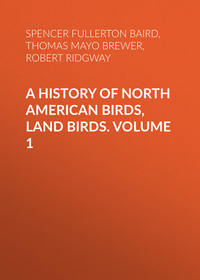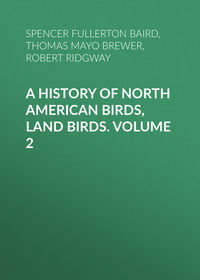 полная версия
полная версияA History of North American Birds, Land Birds. Volume 3
The egg of the Callipepla squamata is regularly oval, being much more elongated than with any other species of this family. It measures 1.35 inches in length by .95 in breadth. Its ground-color is a creamy white, and its surface is minutely freckled with specks of a pale drab.
Genus CYRTONYX, Gould
Cyrtonyx, Gould, Mon. Odontoph.? 1845. (Type, Ortyx massena, Lesson.)
Gen. Char. Bill very stout and robust. Head with a broad, soft occipital crest of short decumbent feathers. Tail very short, half the length of the wings, composed of soft feathers, the longest scarcely longer than the coverts; much graduated. Wings long and broad, the coverts and tertials so much enlarged as to conceal the quills. Feet robust, extending considerably beyond the tip of the tail. Claws very large, the outer lateral reaching nearly to the middle of the central anterior. The toes without the claws, however, are very short. Sexes very different.
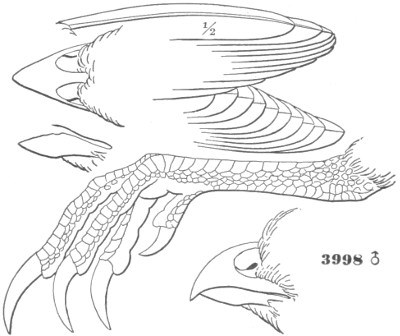
3998 ♂ ½
Cyrtonyx massena.
This genus differs very much from its North American allies in the great development of the feathers composing the wing-coverts, the very short and soft tail, and the very short toes and long claws. It is almost worthy of forming the type of a distinct subfamily, so many and great are its peculiarities. The single North American representative is the only one of our species with round white spots on the lower surface and black ones above. A second species, C. ocellatus, is found in Southern Mexico. They may be distinguished as follows:—
SpeciesC. massena. Shaft-streaks of wing-feathers yellowish-white; sides with small round white spots, medial lower parts dark maroon-chestnut. Hab. Northern Mexico, and adjacent portions of the United States, from the Upper Rio Grande and Colorado Valleys, south to Mazatlan.
C. ocellatus. 117 Shaft-streaks of wing-feathers chestnut-rufous. Sides with large rufous spots, medial lower parts bright rufous, lighter anteriorly. Hab. Southern Mexico, and Guatemala.
Cyrtonyx massena, GouldMASSENA PARTRIDGEOrtyx massena, Lesson, Cent. Zoöl. 1830, 189.—Finsch, Abh. Nat. 1870, 357 (Guadelajara). Cyrtonyx massena, Gould, Mon. Odont. 1850, 14; tab. vii.—M’Call, Pr. A. N. Sc. V, 1851, 221.—Cassin, Illust. I, i, 1853, 21, pl. xxi.—Reichenb. Syst. Av. 1850, pl. xxvii.—Baird, Birds N. A. 1858, 647.—Ib. Mex. B. II, Birds, 23.—Dresser, Ibis, 1866, 29 (Bandera Co., Texas; breeds).—Coues, P. A. N. S. 1866, 95 (Fort Whipple, Arizona).—Gray, Cat. Brit. Mus. V, 1867, 74.—Coop. Orn. Cal. I, 1870, 558. Ortyx montezumæ, Vigors, Zoöl. Jour. V, 1830, 275. Odontophorus meleagris, Wagler, Isis, XXV, 1832, 279. Tetrao guttata, De la Llave, Registro Trimestre, I, 1832, 145 (Cassin).
Sp. Char. Male. Head striped with white, black, and lead-color; chin black. Feathers above streaked centrally with whitish, those on the outer surface of the wings with two series of rounded black spots. Central line of breast and belly dark chestnut; the abdomen, thighs, and crissum black; the sides of breast and body lead-color, with round white spots. Legs blue. Length, 8.75; wing, 7.00; tail, 2.50.
Female. Prevailing color light vinaceous-cinnamon, the upper parts barred and streaked as in the male. Head without white or black stripes. Sides with a few narrow, irregular streaks of black.
Young. Somewhat similar to the adult female, but lower parts whitish, the feathers, especially on the breast, with transverse blackish spots on both webs.
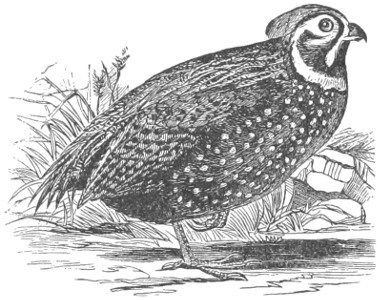
Cyrtonyx massena.
Chick. Head dingy white, with a broad occipital elliptical patch of chestnut-brown, and a blackish streak behind the eye. Above rusty-brown, obscurely spotted with black; a white stripe on each side of the rump. Beneath almost uniform dull white.
Hab. Chiefly on the Upper Rio Grande from the high plains of the Pecos. Fort Whipple, Arizona; Northern Mexico, southward, on the west coast, to Mazatlan.
Habits. This Quail was first met with by Lieutenant Couch in the cañon Guyapuco, about twelve leagues south of Monterey. Though rather shy, they seemed quite at home in the cultivated fields and stubbles of the ranches. Mr. Clark first noticed the species among a flock of the Ortyx texana. Once, on flushing a covey of the latter, a bird was seen to remain behind, and showed no inclination to follow the rest. It attempted to hide in the grass, but did not fly, and, when shot, proved to be a Massena Quail. He says they occur either in pairs or in flocks, and when once flushed fly farther than the Virginia Quail, but do not lie so close. They may be approached within a few feet, and followed up, particularly when in pairs, running along before one like so many domestic fowl. They are of quiet as well as of retired habits, and a subdued though sharp note is the only noise that Mr. Clark ever heard them make, and that only when frightened. He has known them to be pursued, and all the barrels of a six-shooter fired one after another without alarming them; and they were forced to fly at last only by an attack of stones and clubs. He first met with them in the neighborhood of San Antonio, and found them thence sparsely distributed as an inhabitant both of prairies and mountains as far westward as Sonora. They are wilder than the Scaled Partridge, are less conspicuous and noisy, and are never seen in flocks, or, like the latter, living about old camps. Their haunts are generally far removed from the habitations of man, and the indifference they sometimes manifest to his presence seems to be due to ignorance of the danger from the power of that enemy. Though distributed over the same country as the C. squamata, they are never found in such barren regions, always seeming to prefer the districts most luxuriantly covered with vegetation.
Dr. C. B. R. Kennerly states that this bird was never seen farther south in Texas than Turkey Creek. In that vicinity it was very common, and it also occurred at various points thence to the Rio Grande. In the valley of this river it was very rarely seen, giving way apparently to the Scaly and to Gambel’s Partridge. West of the river it was very common, as far as the party travelled, wherever there was a permanent supply of fresh water. In the valley of the Santa Cruz River and among the adjacent hills it was extremely abundant. In the months of June and July it was observed there always in pairs, while in Texas, in the months of October and November, it was found in very large flocks, sometimes of various ages, from the very small and partly fledged to the full-grown bird. When hunted, they hide very closely in the grass, and Dr. Kennerly has often known the Mexican soldiers in Sonora kill them with their lances by striking them either while on the ground or just as they rise. Some of these men were very expert in the business, and obtained a good many in the course of a day’s travel.
Dr. Woodhouse met with this species a few miles above the head of the Rio San Pedro, where he secured a single specimen. He was informed by Captain S. G. French that when he first passed over exactly the same route in 1849, he met with a number of them in different localities,—at the head of San Pedro, Howard Springs, and also at Eagle Springs,—showing evidently that they have a range over the country lying between the Rio Grande and the San Pedro Rivers. He also stated that he had never met with any near the settlements, but always among the wild, rocky, and almost barren hills of that country. They are more sociable and not so shy as the other species of this family. Their food appears to be principally insects.
Mr. Dresser states that this bird is locally known as the Black Partridge. For some time he sought for it near San Antonio without success, but ultimately found it, in November, among the Bandera Hills. In its habits he states it is more like the Texan Quail than any other; but on the wing it is easily distinguished, it flies so heavily, though very swiftly. When disturbed, they squat very close, and will not move until approached very closely, when they generally rise up from under one’s feet. He did not meet with this Quail in any other part of Texas than Bandera County, but was told that it is abundant in the hilly country at the head of the Leona, and that it is also found near Laredo.
In some remarks on the birds of Western Texas, published in the Proceedings of the Philadelphia Academy in 1851, Colonel McCall gives the first information to the public touching the habits of this interesting species. We learn from his narrative that it was not met with by him before crossing the San Pedro River, but that it was soon after seen in the rocky regions into which he then entered; and thence as far as the Rio Pecos, a distance of one hundred and forty miles westwardly, it was frequently seen, though it was not anywhere very common. This entire region is a desert of great extent, north and south; the general face of the country is level, and produces nothing but a sparse growth of sand-plants. Water was found only at long intervals, and except at such points there was apparently neither food nor cover. There, among projecting rocks or the borders of dry gullies, or in loose scrub, this bird was met with by Colonel McCall.
The habits of this species appeared to him to be different from those of any other kind of Partridge he had ever met with. They were in coveys of from eight to twelve individuals, and appeared to be simple and affectionate in disposition. In feeding they separated but little, keeping up all the while a social cluck. They were so gentle as to evince little or no alarm on the approach of man, hardly moving out of the way as they passed, and only running off or flying a few yards, even when half their number had been shot. Colonel McCall was of the opinion that they might, with very little difficulty, be domesticated, though naturally inhabiting a barren waste nowhere near the habitation of man. The call-note is spoken of as very peculiar. The bird was not seen by his party after crossing the Pecos River. Mr. Gould, without any information in regard to the habits or economy of this species, in his Monograph of American Partridges, judging from the comparative shortness of the toes and the great development of the claws, ventured the opinion that the habits would be found very different from those of other members of the family, which opinion is thus confirmed. Mr. Cassin thought he could trace in the circular spots, numerous in the lower part of the body, an analogy in character to the Guinea-fowls, which is further shown by their habit of continually uttering their notes as they feed, and by other similarity in their manners.
Captain S. G. French, cited by Mr. Cassin, mentions meeting with this Partridge in the summer of 1846, when crossing the table-lands that extend westwardly from San Antonio, in Texas, to New Mexico. On the sides of a high rocky mountain near the summit, he observed several of them only a few feet in advance of him. They were running along over the fragments of rocks and through the dwarf bushes which grew wherever there was sufficient soil. He was attracted by their handsome plumage and their extreme gentleness. A few days after, when encamped on the headwaters of the river, he again met with a covey, and from that point occasionally encountered them on the route to the Pecos River, a distance of over a hundred miles. He did not meet with them again until he came to Eagle Springs, in a mountainous region about twenty-five miles from the Rio Grande. In the spring of 1851, on the same route, he saw only two of these birds, and was led to the belief that they are not at all numerous. They appeared to inhabit the rocky sides of the mountains and hills, in the desolate region of elevated plains west of the fertile portions of Texas. In no instance did he meet with any of these birds near the settlements. Wild and rocky hillsides seemed to be their favorite resort, where trees were almost unknown and all vegetation was very scant. The coveys showed but little alarm on being approached, and ran along over the rocks, occasionally attempting to secrete themselves beneath them. In this case they could be approached to within a few feet. When startled by the firing of a gun, they fly but a few yards before again alighting, and exhibit but little of that wildness peculiar to all the other species of Partridge. The contents of the crop in Captain French’s specimens consisted exclusively of fragments of insects, principally grasshoppers. No trace whatever of food of a vegetable character was found.
Don Pablo de la Llave, quoted by Mr. Cassin, furnishes the following account of the habits of this Partridge, observed by him in specimens taken near the city of Mexico.
“It is only a few days since the third species has been brought to me. It is rather smaller than the former (C. squamata), and its deportment is entirely different. It carries its head habitually resting on its shoulders, the neck being excessively small and deflexed, and in everything it shows an amiability, and, so to speak, kindness of character (una bondad de caracter), which is not found in any other species of this genus, and it is naturally so tame and domestic as to permit itself to be caught with the hand. These birds are always united, forming a covey, and whenever one is separated the others follow it. They do not, like others, wish to sleep on elevated places, but sit on the ground, drawing very near together. Their notes, which are not varied, are very low and soft, and I have never heard loud cries from the male. When they are frightened they show much activity and swiftness; at other times their gait and movement are habitually slow and deliberate, carrying the crest puffed up (espayada).”
APPENDIX
I.
ADDITIONS AND CORRECTIONS
During the considerable interval of time since the printing of this work was commenced, many additional facts have come to light in regard to the habits and geographical distribution of the land birds of North America; and while several so-called species have proved to be mere races, or even of less rank, some others have been added to the list. The more important of these are herewith subjoined.
Most of the new facts here announced are the results of the more recent labors of Captain Charles Bendire, First Cavalry, U. S. A., and of Messrs. J. A. Allen, C. E. Aiken, Dr. E. Coues, H. W. Henshaw, Mr. C. J. Maynard, and others, whose names are mentioned in their appropriate places.
Turdus pallasi, var. nanus (I, 20). Dr. Cooper has sent to the Smithsonian Institution skins of his T. nanus, and they prove to be T. ustulatus. The surmise expressed on page 21, that the nest and eggs described by Dr. Cooper as those of the former in reality belonged to the latter species, is thus undoubtedly correct.
Turdus pallasi, var. auduboni (I, 21). A nest with the eggs (S. I. 16,320) of this species was taken near Fort Ellis, Montana, July 16, 1872, by C. H. Merriam, attached to Dr. Hayden’s party. The nest is large and bulky for the size of the bird, is deeply saucer-shaped in form, measuring 6 inches in external diameter by 3 in depth. The cavity of the nest is 3 inches in diameter by about 1.75 deep. It is composed entirely of green mosses and lined with fine grass leaves.
The eggs were three in number, in shape broadly ovate and obtusely rounded at either end. They measure .85 of an inch in length by .72 in breadth; their color is a rather deep greenish-blue, almost exactly like those of Turdus migratorius.
The nest was built in a small pine-tree, about eight feet from the ground, in the pine regions of the mountains. In its position it differs from any now known of the Turdus pallasi, which, so far as known, builds invariably on the ground.
Harporhynchus ocellatus (I, 36). This is probably a Mexican form of H. cinereus.
Harporhynchus rufus (I, 37). According to Mr. Allen (Bull. Mus. Comp. Zoöl., Vol. III, No. 6, p. 134) this species is found on the eastern slope of the Rocky Mountains in Colorado. It is not included in the “Birds of California,” but Dr. Cooper states that in September, 1870, he found a straggler at Clear Lake, close to the lower town. It was in a thicket with its western cousins, but possessed unmistakably all the characteristics of the eastern bird. Unfortunately, it was not secured. As this species is short-winged and nearly resident in many localities, its occurrence so far from its usual resort is somewhat remarkable. It had none of the appearance of a cage-bird.
Harporhynchus curvirostris, var. palmeri (I, 43). Four specimens from Tucson, Arizona, were recently forwarded for examination by Dr. Coues, collected by the indefatigable Captain Bendire, U. S. A., when stationed at that post. The specimens are all true palmeri in the characters which definitely separate it from curvirostris, its nearest ally, and show the seasonal discrepancies in the shades of color. A male and female, collected in November, differ from the types, which are summer birds, in being of a brownish-plumbeous above, even more ashy than in any specimens of curvirostris which we have seen. In all other respects, however, they are typical examples of var. palmeri, and substantiate the validity of this well-marked form. The measurements of these two specimens are as follows:—
♂. Wing, 4.50; tail, 4.90; culmen, 1.45; tarsus, 1.25; middle toe, 1.00.
♀. Wing, 4.20; tail, 4.80; culmen, 1.40; tarsus, 1.20; middle toe, .90.
The description of this form was first published by Dr. Coues in “Key to North American Birds” (October, 1872), p. 351, the type being specimen No. 61,589, Mus. S. I.
Harporhynchus bendirei, Coues (Am. Nat. Vol. VII, June, 1873, p. 330, fig. 69).
Char. Nearly similar to H. palmeri in color, but whiter on the breast, and apparently more ochraceous on the flanks. Much smaller than H. palmeri, with smaller and very differently shaped bill. Male (not adult), No. 2,686, Mus. E. C. Wing, 4.10; tail, 4.50; culmen, 1.15; tarsus, 1.20; middle toe, .88. Female (adult), No. 2,688, Mus. E. C. Wing, 3.80; tail, 4.40; culmen, 1.15; tarsus, 1.15; middle toe, .88.
Hab. Tucson, Arizona.
This new form Dr. Coues considers to be most nearly related to the H. cinereus of Cape St. Lucas; and judging from its eggs, lately sent to the Smithsonian Institution by Captain Bendire, such appear to be really its affinities.
The eggs sent by Captain Bendire (No. 16,486, Mus. S. I.) measure 1.00 in length by .80 in breadth, and are three in number. Their ground-color is a dull bluish-white, spotted with a very faint shade of reddish-brown, the spots thickest round the larger end.
Harporhynchus crissalis (I, 47). Captain Bendire found this species breeding abundantly near Tucson, Arizona (See Coues, Am. Nat. VI, June, 1872, 370). The eggs in all instances were similar to those described as found by Dr. Palmer, unspotted, and in size, shape, and color, hardly distinguishable from the eggs of the common Robin (T. migratorius). They are of an oblong-oval shape, rounded and nearly equal at either end, and measure 1.10 inches in length by .75 in breadth.
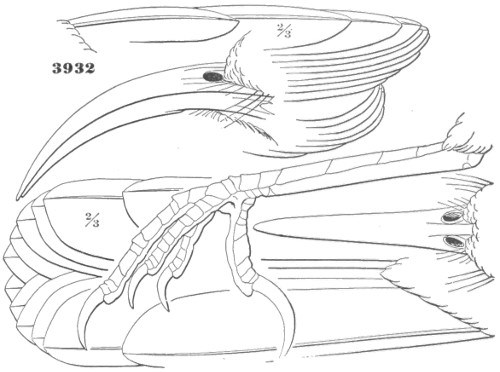
3932 ⅔ ⅔
Harporhynchus redivivus.
Harporhynchus redivivus (I, 45). The accompanying cut, showing the extreme anatomy of the species, was omitted in its proper place.
Mimus polyglottus (I, 49). Mr. C. E. Aiken has obtained this species in El Paso County, Colorado.
Saxicola œnanthe (I, 60). Mr. C. J. Hampton obtained a specimen of this bird at Junius, Seneca County, N. Y., on the 9th of September, 1872. Professor Newton suggests, by letter, as an interesting problem, the route by which this species reaches Alaska in its migrations. It is not known to occur near the Sea of Ochotsk, has not been found on the Lower Amoor, and probably does not occur farther eastward than the Baikal Mountains. It has never been noticed in Japan or on the coast of China. It must therefore be very nearly certain that it cannot take that way to Alaska. Sundeval states that it is found in Kamtschatka, but this Mr. Newton questions, as no authority is given for this statement. The only alternative is to assume a route via Greenland, in this, perhaps, in a measure indorsing Petermann’s suggestion that Greenland extends across the pole nearly to the Asiatic coast and to Alaska.
Sialia mexicana (I, 65). This species has been obtained in Western Iowa by Mr. Atkinson.
Regulus calendula (I, 75). We present the outlines of bill, feet, wings, and tail, omitted in their proper place.
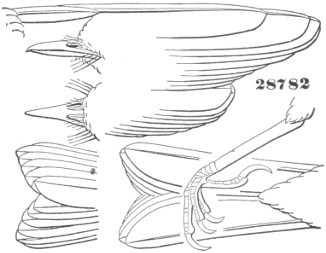
28782
Regulus calendula.
Polioptila cærulea (I, 78). Mr. Aiken has taken this species in El Paso County, Colorado. Dr. Cooper informs me that he found it quite numerous near Auburn, Placer County, Cal., May 11, 1870, apparently migrating northward. In the following December he saw one near San Francisco. From this he infers that it winters much farther to the north in that State than it does east of the Rocky Mountains, and that the individuals occurring in Guatemala are eastern birds. He also states that it is the prevailing and probably the only form in all the northern and western parts of the State of California. About September 20, 1872, this species came in great numbers to the vicinity of San Buenaventura and remained there all winter, going to the mountains northward by March 20.
Polioptila melanura (I, 81). Dr. Cooper informs me that while he found P. cærulea common in September, he saw none of this species near San Buenaventura until November 12, when small parties appeared moving westward from the colder desert regions east of the mountains. They kept entirely in the artemisia thickets among the sandy and dryest tracts, never going into the high trees like P. cærulea. In form, color, restless habits, and scolding mew, this species is said to be a perfect miniature and mimic of the Catbird.
According to Captain Bendire the species is not common in Arizona, where he met with three nests. “One before me, found July 25, 1872, fastened in a bunch of mistletoe, or rather suspended in it, is composed of a species of wild hemp fibres nicely woven together, and lined with a few feathers and exceedingly fine grass.” The nest is very neatly made: Outer diameter, 2 inches; inner, 1.60; depth, 1.50. The number of eggs is five, ground-color pale green, with spots of light reddish-brown color scattered over the egg. Measurement, .50 by .40 of an inch. Their notes are a rather harsh twitter, kept up for some time. They are active little birds, and are very restless.
Chamæa fasciata (I, 84). Mr. Allen thinks that he saw this species in Colorado Territory. See Am. Nat. VI, June, 1872, and Bull. Mus. Comp. Zool. III, No. 6, p. 184.
Lophophanes inornatus (I, 91). Mr. Aiken has obtained this species in El Paso County, Colorado, where it is common, while Mr. Henshaw, the naturalist of Lieutenant Wheeler’s expedition, found it abundant in Southern Utah. These Rocky Mountain specimens are much grayer and somewhat larger than those from California.
Parus rufescens (I, 104). Nests and eggs of a Parus which undoubtedly belong to this species were found by Mr. William A. Cooper, at Santa Cruz, Cal. One of these nests, sent to the Smithsonian Institution, was found about four miles from Santa Cruz, April 22, 1873. The nest was composed of moss and fine bark, largely intermingled with the fur of rabbits and other small quadrupeds. It was built in a hole in the branch of a tree about ten feet from the ground. The branch was about half a foot in diameter and was partially decayed. The cavity was about a foot in length from the nest to the place where the bird gained an entrance, which was a small hole about an inch and a quarter in diameter. The eggs were seven in number and contained partially formed embryos. They measure .64 of an inch in length by .52 in breadth, resemble the eggs of the atricapillus, but are more sparingly marked with spots, rather more minute and of a lighter shade of reddish-brown, on a white ground.


